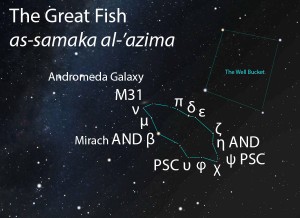Star Names
The Great Fish (as-samaka al-‘azima)
The Belly of the Fish (batn as-samaka)
The Great Fish is one of two fish in the Arabian stellar sea. The brightest star within this asterism was called the Belly of the Fish on account of its location. It was also sometimes called the Heart of the Fish (see al-hut) on account of its red color.
The Great Fish as as-samaka al-‘azima is identical in appearance to al-hut. Only the names and their uses differ. Grammatically, samaka is any fish, and the adjective ‘azima means great or large. In contrast to this, the word hut in itself indicates a large fish.
Appearance
A bright orange star located to the east of the four bright stars that form the shape of a large, near-perfect square, known in modern times as the Great Square of Pegasus. This star itself is the Belly of the Fish, and the faint stars that circle through it form the rest of the Great Fish. It shape is formed by two chains of stars that emanate from its mouth (the Andromeda Galaxy) and extend to its tail in modern-day Pisces. The stars listed below have been identified as making up the outline of the Great Fish, but other stars along these chains were no doubt part of the picture.

The Great Fish (as-samaka al-‘azima) as it appears in the east under dark skies about 1 hour after sunset in mid-October. Sky simulations made with Stellarium.
Modern Identification
The Belly:
β AND (Mirach), red giant, magnitude 2.5
The Fish:
M31 (Andromeda Galaxy), spiral galaxy, magnitude 3.5
ν AND, blue-white star, magnitude 4.5
μ AND, white star, magnitude 3.9
υ PSC, white star, magnitude 4.7
φ PSC, orange giant, magnitude 4.7
χ PSC, orange giant, magnitude 4.7
ψ1 PSC, blue-white double star, magnitudes 5.6 and 5.8
η AND, yellow giant, magnitude 4.4
ζ AND, variable orange giant, magnitude 3.9-4.1
ε AND, yellow giant, magnitude 4.3
δ AND, orange giant, magnitude 3.3
π AND, blue-white double star, magnitudes 4.4 and 8.6
Timing
The Great Fish was also known as a lunar station by a synonymous name, the Great Fish (al-hut). Ibn Qutayba (d. 879 CE) reported that the Great Fish was said to rise on the morning of April 4 and set on the morning of October 5. On account of the precession of the equinoxes, today we can expect to observe the Great Fish setting in mid-November and rising at the end of March, as seen from the latitude of Tucson. (See How to Observe on the About page for more on this topic.)
Rain Stars
The Great Fish does not figure among the rain stars.
Lunar Stations
The Great Fish is also one of the lunar stations when called by the term al-hut. In early listings of the lunar stations, the Great Fish is the second station of the year. This was later changed to the 28th lunar station after the stations were adjusted to begin with the vernal equinox.
Related Stars and Celestial Complexes
The Great Fish is part of the Two Fish (as-samakatan, السمكتان) folkloric celestial complex. The other fish of the pair is the Smaller Fish (as-samaka as-sughra, السمكة الصغرى).

